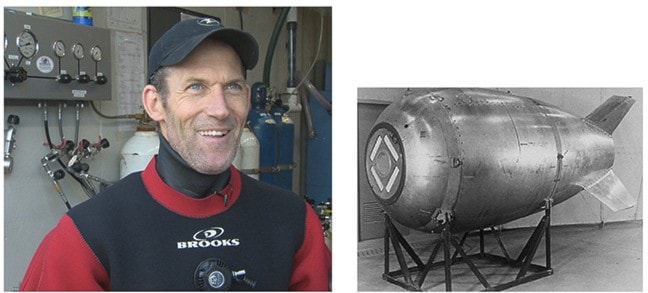Erin Haluschak
Record staff
Buried in the sea floor, the object was large, circular and relatively flat, leading Courtenay diver Sean Smyrichinsky to the possibility that he found a UFO.
Instead, the owner of UB Diving now believes it may be a ‘lost nuke’ - a Mark 4 bomb which went missing after a U.S. bomber crashed in northern B.C in Feb. 1950, flying from Eielson Air Force Base near Fairbanks, Alaska, en route to Carswell Air Force Base in Fort Worth, Texas.
While working with a friend harvesting sea cucumbers earlier this month, Smyrichinsky was diving on the inside of Haida Gwaii, south of Prince Rupert.
It was getting near the end of the day when he took an underwater diver propulsion vehicle (DPV) and scouted an area to fish the following day.
“When I’m flying above the bottom, looking down, instead of the general rocks that I was typically seeing, I saw a really large circular object that was flat on the top but had a hole cut out of it and I thought, ‘that’s pretty strange.’ So I flew overtop of it,” he told CTV Vancouver Island.
At first Smyrichinsky thought it may have been a rock formation, but he quickly realized it wasn’t a natural object.
“I’ve been diving a long time, and I’ve never saw anything like that before. I couldn’t imagine what part of a ship that would come off of, and I couldn’t imagine a ship big enough to carry it getting to where I was.
“I really had no idea what it was or where it came from. Because it was round and bowl-shaped, I thought, UFO.”
When he described his find to the crew on his ship, the skipper encouraged Smyrichinsky to draw the object with a sharpie on a napkin, as he didn’t take a camera with him on the trip.
After telling friends of his discovery, he quickly learned of the story of the Mark 4 bomb. Once Smyrichinsky Googled the story and found schematic drawings, he began to put his discovery into perspective.
“… when I saw a schematic of the bomb, one of the pieces on the schematic looked very much like what I saw. So that got my mind thinking, and then we realized that where we were diving was only about 50 miles from where the plane crashed. That really got my heart racing. That’s when I sent a Facebook message to my friend in the military.”
The Convair B-36 took off from Eielson on Feb. 14 on a flight which simulated a nuclear strike combat mission against the Soviet Union.
The plan was for a simulated bomb run at the beginning of the Cold War, to southern California and then San Francisco and to continue to Fort Worth. Cold weather affected the plane, and the crew decided to abandon the aircraft because it couldn’t stay aloft with three engines not working while carrying a heavy payload.
According to reports, the bomb - which was just a test round (not containing any active nuclear material) - was jettisoned and detonated in mid-air.
Smyrichinsky eventually contacted officials at CFB Esquimalt, who will make their way up to the site for further investigation, and he is planning on joining them along with a minesweeper.
While he was using a DPV at the time, he does have the GPS co-ordinates of where the boat was anchored.
Cmdr. Michele Tessier of CFB Esquimalt confirmed the HMCS Yellowknife will make its way to the site and use a remote operated vehicle to take photos and video to determine if the object is indeed the Mark 4 bomb.
She added they have been in consultation with American allies, and once they receive confirmation on the object, it will be up to them to determine what might be done.
The bomb is not believed to contain any active nuclear material.
